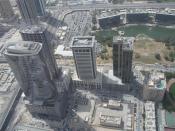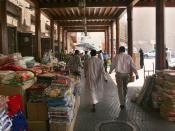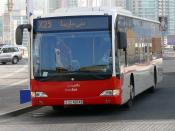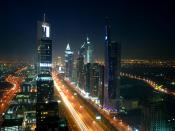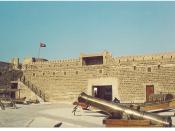Case study:
DUBAI
Students: Tatjana Perovic & Alvaro Hernández
Professor: Sonia Gil-Gibernau Lluis
Course: International Tourism Management
Date: 29/04/2009
Academic year: 2009-2010
DUBAI
Dubai has been developing in the last 15 years into a cosmopolitan and post-modern metropolis. This new character of the city is reflected in its world-wide image, architecture, lifestyles and population. International tourism plays a major role in re-shaping and re-modeling Dubai. The city is becoming a synonym for the trendiest, most modern and technically advanced, most luxurious and sophisticated as well as of the biggest and the tallest. The hotels of Burj al-Arab and Hydropolis, the artificial islands of the Palm and the World, the entertainment complex of Dubailand and the Dubai Tower are landmarks not only of Dubai, but of international architecture as well.
Discuss what you consider to be the three most important reasons for the successful development of Dubai as a tourist destination, in recent years.
Geographical position
Due to its excellent geographical position Dubai has been able to act as a connecting link between Europe and the Indian subcontinent, the Far East and Africa.
It is functioning as intermediary between these immensely different cultures, plus with development of air travel significantly increased the number of visitors who come to Dubai. Therefore, Dubai's geographical proximity to the Middle East, the Indian Subcontinent and Central Asia, combined with its easy access to Europe and the Eastern Mediterranean make Dubai the location of choice for many businesses. Delightful winter climate complemented by a highly sophisticated infrastructure and crime-free environment, have also contributed in recent years to create an ideal atmosphere for the development of tourism. Dubai is also endowed with an extensive coastline, sandy beaches and varied landscape, where a wide variety of activities can be indulged, ranging from powerboat races to sand-skiing. In addition, the country's cultural heritage, accessible in the many cultural centers and at traditional sports such as falconry, camel- racing and horse-racing, has been a powerful attraction for tourists.
Proactive governance and investments in infrastructure
Dubai's construction projects are vital to Dubai's tourist industry. Dubai's construction projects are absolutely main attractions for tourists. Dubai is the city at the forefront of architectural innovation beating all other world cities like New York, London, etc. The most important fact for tourism development in Dubai is the speed of development and the quality of architecture and design. Dubai could be seen as central architectural destination. Dubai become a much sought after venue for conferences, regional and international exhibitions and major sports events such as the Dubai World Cup, the Dubai Desert Classic Golf Tournament, and polo and cricket competitions. In Dubai there is evidence of a common commitment to growth and a willingness to intervene and invest on the part of governments as from public sector. Dubai is growing at a fairly rapid pace. Marketing plays a crucial role in the development of tourism industry and has resulted in the success of Dubai Shopping Festival (DSF) and Dubai Summer Surprises, among others. Dubai, because of its political stability and infrastructure, is an attractive safe place for Middle Eastern capital, much of it pumped into the booming tourism industry which aims to draw 15 million tourists a year from 2010.
Air transport
Air transport networks have allowed small, low-populated place like Dubai to become major international tourism destinations. Dubai used tightly combined airline, airport and tourism strategies to help achieve this. The development of tourism in Dubai could be analyzed as a result of interactions between their airlines, airports, governments and tourism authorities, and how integrated management strategies leveraged aviation traffic hubs to develop tourism destination. Also, Dubai is famous by airports duty free shops. Dubai Duty Free is recognized as being one of the best in the world, if not the best. The shopping complex in the central foyer of the new concourse with its spectacular design and myriad product ranges is a unique shopping experience. Dubai Duty Free stocks a massive range of cosmetics and perfumery, jeweler, electronic goods, music, tobacco goods, and duty free beverages.
Discuss the potential issues involved when tourism develops at a rapid pace, as has happened to Dubai
Despite numerous attractions in Dubai, problems have occurred as a consequence of the fast and sometimes uncontrolled growth that can cause degradation of the environment and loss of local identity and traditional cultures. Tourism in Dubai is large industry and one of its fastest growing economic sectors. This causes different impacts on people lives or on the environment Socioeconomic and cultural impacts include entry of people and related social degradation, impacts on local communities and on cultural values. The increase in tourism activities can cause difficulties for the people searching for employment or entrepreneurial opportunities, and maybe not finding appropriate jobs, that will cause social degradation. Also tourism activities can cause intergenerational conflicts and may affect gender relationships, besides traditional practices and events may also be influenced by the tourist preferences. Tourism can have an adverse effect on local culture, traditions and the way of life. Large numbers of tourists can undermine traditional beliefs, values and customs and in particular risk commercializing the very culture that they find so interesting. Therefore, the major problem an economy built on tourism is exploitation. This exploitation can also be seen in Dubai through the changes forced on the culture. The transition to tourism has forced native to adopt western ideas and culture. The nomadic life still that was once common in the region has been for the most part lost to a more western style of living. Another issue of fast development is the overuse of resources, such as water and land used for tourism. The resources in tourism are devoted to people that will not stay for long within the community. This makes them more likely to use resources wastefully because it was little impact on them once they leave. This affects the ability of permanent residents to get the amount of resources they need to survive. This is only added to be the increased number of people that come into the society that are now fighting for the same resources.
Compare and contrast the development of tourism and the main characteristics of the tourism industry, in Dubai and either Turkey or Egypt.
Tourism in Dubai is an important part of the Dubai government's strategy to maintain the flow of foreign cash into the emirate. Dubai's lure for tourists is based mainly on shopping, but also on its possession of other ancient and modern attractions. The Department of Tourism and Commerce Marketing its taking care about the Tourism Industry.
Dubai is the most populous emirate of the seven emirates of United Arab Emirates. It is distinct from other members of the UAE in that revenues from petroleum and natural gas account for only 6% of its gross domestic product. A majority of the emirate's revenues are from the Jebel Ali Free Zone (JAFZ) and now, increasingly, from tourism.�
Independent studies show that the tourism industry has accounted for a steadily increasing percentage of Dubai's GDP, with some estimates putting it as high as 20 per cent. In fact tourism is expected to over take oil exports as an important source of revenue in the near future. Dubai's 255 hotels have a total of 17,253 rooms and occupancy in 1998 averaged 49.3 per cent. Since January 1997 when the Department of Tourism and Commerce Marketing (D TCM) took over from the Tourism and Trade Promotion Council, there has been renewed focus on worldwide promotion of Dubai as an ideal tourist destination and a thriving commercial center. This has involved setting up the DTCM representative offices in many countries across the globe as well as participation in numerous international tourism fairs. In addition, the DTCM has launched very successful advertising campaigns worldwide. The DTCM also organizes tourism-related exhibitions in Dubai. Early in 1999 it hosted the Arabian Marine Tourism Conference, the first of its kind to be held in the region. In May more than 500 exhibitors from 40 countries participated in the Arab Travel Market 99, which was also held under the auspices of the DTCM. Not surprisingly, since the number of tourists is expected to reach three million by the end of the year 2000, Dubai has a number of major tourism-related projects coming on-stream.�
Dubai continues to be the premier holiday destination of choice for countless travelers and travel operators throughout the world. Recognized as the leading centre for business across the region, the hub for international finance together with outstanding opportunities for investment in the real estate sector - nothing is overlooked. The continuing development is solidly supported by the service and business infrastructure demanded by a 'Metropolis for the Millenium'. Dubai - Simply Accessible is positioned as resource to help develop and raise awareness of the accessibility of the facilities in Dubai.
Yet, as Dubai thrives it continuously strives to set new standards of excellence. As the Emirate evolves and invites the most discerning of travellers to enjoy the very best holiday and travel destination in the world, it is determined that the unique Dubai experience can be enjoyed by each and everyone. Through Dubai Simply Accessible they invite to visit an open and hospitable destination as work continues to make Dubai accessible to all of our very special guests.
Meanwhile, tourism in Turkey is taking by the Ministry of Tourism, is focused largely on a variety of archaeological and historical sites, and on seaside resorts along its Aegean and Mediterranean coasts. In the recent years, Turkey has also becoming a popular destination for religious, spa, and health care tourism. One-third of international tourism revenue is in the Mediterranean basin, while four Mediterranean countries (Spain, France, Italy and Turkey) are among the top 15 tourism destinations based on international arrivals in 2004 (WTO 2005; EU Parliamentary Assembly 2003). The concentration of tourism activities on coastal areas, especially in the Mediterranean countries, has accelerated population increase and urbanization in these areas and has also increased regional-spatial economic disparities (WTO, 2002).
Despite its natural, historical and cultural appeal for tourism potential, Turkey has not been able to get the share it deserves from the Mediterranean basin. It is observed that the tourism income of Spain is 26% of the Mediterranean basin while the tourism income of Turkey is 7%. Tourism demand and revenue is especially concentrated in three major destination countries (Spain, France, Italy) in the Mediterranean. Moreover, the population concentration in coastal areas is more than the share of the coastal land; therefore the density is much higher than inland areas. In Turkey, Mediterranean coastal lands cover 16% of the countries and the population of these lands is 20% of the total population (Blue Plan 2004).�
In the case of Egypt, Tourism is a major foreign exchange earner, with 9,990,000 foreign tourist arrivals in 2007. Egypt has been always a country of tourism where Europeans used to âÂÂvisit and see its antiquities dating back to the various eras and âÂÂcivilizations. In the recreational tourism domain, there are scores of âÂÂunique tourist destinations such as Sharm -el-Sheikh, Hurghada, Safaga âÂÂand others. Moreover, Egypt is renowned for therapeutically and âÂÂenvironmental tourism as well as other kinds such as Safari, conferences âÂÂand sports.âÂÂ
Egypt was known throughout its history as a destination for tourists and travelers since it was visited by "Herodotus" during the ancient time, when he got surprised because of the vast difference between Egypt and his homeland. Egypt maintained this image throughout the middle and modern history. However, the discovery of the Pharaonic antiquities long time ago has added a special charm to Egypt, besides its unique religious and cultural monuments. On the other hand, Egypt enjoys a geographical location, and a moderate climate all the year-round, along with its smooth vast coastlines, and beaches with its unique treasures of coral reefs, providing Egypt with advantages of a competitive edge.�
Egypts economy is the most varied of the Middle East economies, where sectors of tourism, agriculture, industry and service contribute at almost equal rates in the national production. Consequently, Egypt s economy is picking up development at increasing rates, based on a climate luring investments represented in proper legislation, convenient policy, internal stability, trade and market liberalization. This is besides what Egypt possesses of solid infrastructure of transportation, communication, energy sources, skillful manpower, modern industrial communities, banking system and stock market
.
Imagine you have been appointed as a consultant to develop a sustainable tourism strategy for Dubai. You should produce report that:
identifies the main threats for the sustainable development of tourism in Dubai in the future
suggest policies and initiatives that could make the future development of tourism in Dubai more sustainable
Threats for the sustainable development of tourism in Dubai in the future
The main problem in Dubai in future will be traffic due to the increase in number of cars and people living in Dubai. People have shifted to Dubai from their home countries searching for job opportunities and leisure entertainment. Dubai has been attracting in tourists to buy property with added incentives, like giving them a 99 year visa once they buy a property in certain chosen places. Also, free zone communities in Dubai have been developed for foreigners to open up their own businesses without taking taxes. Those people coming in to Dubai need places to live in, and therefore constructing residential places, villas, hotels and apartments for accommodation has taken almost 50% of the working force in Dubai to build up the real estate sector. Due to all of this congestion has been created almost everyday in main highways in the city.
Also, problems have occurred with pollution to wildlife habitats and wildlife behavior due to too many tourists, this has been seen in the construction of the Palm Islands. The Palm Islands are technically artificial peninsulas constructed of sand dredged from the bottom of the Persian Gulf. The sand is sprayed by the dredging ships on the required areas, whereas the outer edge of each Palm's encircling crescent is a huge breakwater constructed of carefully placed rocks that were collected by blasting. This in a result has affected the marine environment and animals such as whale sharks, dolphins and whales that got disturbed by the increasing number of dredging ships. Tourism can damage coral reefs, pollute beaches and destroy the habitats of wildlife as roads and hotels are built. Damage to these natural resources is likely to reduce future numbers of visitors. Another negative effect is that the increasing numbers of airplane flights are a major cause of global warming.
Natural resources have been affected by tourism development where it placed pressure on water and air. The air pollution is a result of the emissions from vehicles and airplanes, although tourism isn't directly affecting the overall emissions problem, yet the ozone destruction, the greenhouse effect and global warming made tourism related air pollution a concern. The tourism by air has more than 60% of air travel and is therefore responsible for air emissions.
A water resource is a prime attraction for tourism and recreational developments, and thus has impacts. The water pollution is a result of waster water generated by tourist facilities, hotels, swimming pools, golf courses and personal use of water by tourists. This can result in water shortages and degradation of water supplies, as well as increase in volume of waste water. In dry areas as Dubai the issue of water scarcity is a concern, because of the hot climate and the tendency of tourists to consume more water when on holiday than they do at home.
Dubai has been producing large quantities of waste products from hotels, airlines, attractions and other related businesses that serve the tourists. The waste management programs and technologies in Dubai are poorly managed. The waste disposal is a serious problem and improper disposal can be a major despoiler of the natural environment such as, beaches, scenic areas, and roadsides. On the other hand the construction of hotels, recreation and other facilities often lead to increased sewage pollution. Wastewater has polluted seas and lakes surrounding tourist attractions, damaging the flora and fauna.
Sewage runoff causes serious damage to coral reefs because it stimulates the growth of algae hindering their ability to survive.
Policies and initiatives that could make the future development of tourism in Dubai sustainable
Intact nature habitats are and will be an important precondition and the basis for tourism activities. Strategies need to be developed on how to conserve resources and to reduce emissions. It also needs an environmental planning concept, which guides the way to a more environmental sustainable tourism and related activities on all levels. Therefore sustainable tourism development guidelines and management practices must be taken as a solution. In addition, sustainability principles deal with environmental, economic, and socio-cultural aspects of the tourism development to provide a balance between them to guarantee a long-term sustainability.
Therefore sustainable tourism should include:
The use of environmental resources in tourism development and maintaining essential ecological processes and helping to conserve natural heritage and biodiversity.
Respect the socio-cultural authenticity of host communities, conserve their living cultural heritage and traditional values, and contribute to inter-cultural understanding and tolerance.
Ensure viable, long-term economic operations, providing socio-economic benefits to all stakeholders, including stable employment and income-earning opportunities and social services to host communities.
Dubai must set up a plan that is based on unusual standards as well as going further through focusing on the following tourism areas: eco-tourism, accessible tourism for disabled people, culture, desert, sea, sports and leisure, etc. Establishing committee a proposed tourism plan for Dubai must aim at:
Establishing added value tourism networks combining different destinations and attractions.
Initiating the cooperation of the neighbor countries in the promotional programs of tourism.
Governments should continually revise environmental laws to find practical and effective solutions to the environmental problems. For example there should be rules for the following:
The polluter pays principle: where the tourism operators, such as Hotels must be responsible for causing environmental problems.
Special working groups: to be appointed to solve problems in major tourism destination in Dubai, in coordination with related departments or organizations, such as Municipalities or other organizations to share resources and energy in resolving physical and social problems of the environment.
Promotional measures: to make an on-going campaign to make the public aware of environmental conservation in tourism. It should have information on environmental conservation via the mass media.
Futuristic strategy that will enable us to occupy the suitable position in the world f digital economy.
,
ï Expand the ways of managing the huge production of waste that is happening in Dubai
Aware the tourists and the citizens of the importance of reducing the productivity of waste per person, and to tell them about the harms of pollution and waste.
� http://en.wikipedia.org/wiki/Tourism_in_Dubai
� http://www.uae.gov.ae/Government/tourism.htm
� http://www-sre.wu-wien.ac.at/ersa/ersaconfs/ersa06/papers/494.pdf
� http://www.sis.gov.eg/En/Tourism/Introduction/060100000000000001.htm
�PAGE � �PAGE �5�
